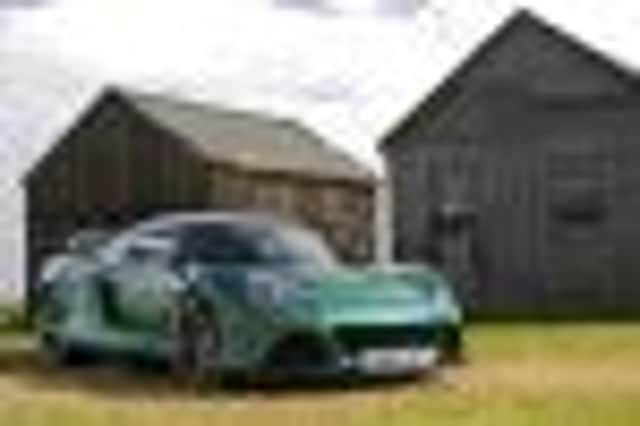Serious scrapper metal


It’s not inevitable that as cars develop through generations, they get fatter and more dull-witted. At first glance, that would appear exactly what’s happened to the Lotus Exige, each successive model getting more power and more weight added. In any other company, this would generally be an indicator of lazy engineering, but this is Lotus and things are done very differently in these parts. The Norfolk company is in a period of transition from a manufacturer of relatively inexpensive lightweight sports cars to one that markets a more aspirational selection of hardware.
This sounds like bad news if you love lightweight sports cars, although looking at the sales figures in recent years, it’s clear that not enough of us do. The latest Exige would suggest that there’s little to worry about. It hasn’t got fatter. Poke it. That’s muscle right there.
Advertisement
Hide AdAdvertisement
Hide AdThe engine will be familiar to many. It’s the Toyota Camry-sourced 3.5-litre V6 that debuted in the Evora S and which is supercharged to a heady 345bhp. Yes, that V6 is a much heavier engine than the four pot unit it replaces, but the extra 125kg is more than offset by the increase in power, and Lotus has worked to position the engine low and as far forward in the middle of the car as possible. Power to weight ratios are up significantly, from 239bhp/ton in the old S model to 331bhp/ton. Things have got very serious indeed.


Performance is suitably ludicrous, with the Exige smashing its way from standstill to 60 in less than four seconds. It’ll make 100mph in about eight seconds, or only about a second shy of a Ferrari 458 Italia. A three-stage DPM (Dynamic Performance Management) system is standard, with both Touring and Sport settings in addition to full deactivation. An optional “Race” pack adds a fourth mode which features a launch control system so you’ll be able to replicate the acceleration figures of Autocar’s team of lead-foots. With a kerb weight of 1080kg, rest assured the Exige has not succumbed to middle-aged spread.
As I do a few circuits of the Exige to take in each angle, it’s clear that although the extra 7cm grafted into the car’s wheelbase has given it a good deal more presence, it has also changed the character of the car. The Exige no longer looks like a pugnacious little terrier that’s going to hang off your trouser leg. Instead it’s morphed into something a bit more sensual and elegant. I’m not 100 per cent convinced of some of the detailing, especially around the rear end, but the look is more mature and composed. Gone is the roof scoop, replaced by a low profile ventral ridge.
In fact, if you take exception to this, you can do away with the roof altogether and opt for a roadster version. Beforehand, the idea of an Exige roadster would have been faintly ludicrous as that would have been an Elise, but there’s now a clear justification for an open Exige – and it’s just stunning. The manual soft-top roof takes a bit of getting used to if you’re accustomed to clever flip-top units that disappear at the touch of a button, but it’s a small price to pay for getting a more intense Exige experience.
Advertisement
Hide AdAdvertisement
Hide AdIn becoming more expensive, this Exige actually seems better value for money. Stick with me on this one. Lotus had long trotted out quotes about hot Exiges being the quickest car they’d ever produced, but most of us recalled the wonderful V8 Esprits of years gone by and never thought the Exige competed in anything like the same sphere or carried the same charisma. Yes, the Exige was probably more fun and quicker round a circuit, but it always felt unworthy of comparison with the magical Esprit. It was just a very different car.


Although elements of the latest car continue the Exige theme, it’s a model that now feels a lot more grown up. Lotus even demonstrated a Roadster with some beautiful quilted leather finishes and carpets. While this may send some hardcore Lotus fans into fits of apoplexy, the company needs to move with the times. If making the car more civilised costs 0.2 of a second around the Brands Hatch Indy circuit but doubles Exige sales in the process, any true Lotus fan should be fine with that.
Lotus Exiges have always fared well in terms of running costs as depreciation is very low and fuel economy is excellent. The light weight also means less of a toll is taken on the usual consumables such as tyres, brakes and clutches. This Exige S variant features a combined fuel consumption figure of 28mpg and emissions of 236g/km. While these figures don’t look so amazing, when couched in terms of the performance and the fact it’s a 3.5-litre supercharged petrol engine developing them, it represents a very cost-effective way to give a Porsche 911 GT3 a good fright.
But Lotus hasn’t forgotten that its first duty is to entertain. The addition of the roadster model is a smart move. While it may have initially confused a few observers, the Exige roadster’s powerhouse of an engine means that this is not just an Elise with a bit of interior decorating undertaken. It weighs little over a tonne, yet packs a 345bhp punch.
Advertisement
Hide AdAdvertisement
Hide AdAlso, the Exige now works so much better as a dual-use road and track car. Previous generations felt at home on a circuit but compromised on the road. However, the bigger engine and improved interior means the Exige is no longer quite so raw.
The roadster version also gets a bit closer to the sonorous growl of the V6 engine. Previous Exiges were best used with ear plugs. The easy snap judgment to take with this latest model is that it’s become a bit porky in middle age. The truth? It just got a whole lot better.